American Brazilians
An American Brazilian (Portuguese: américo-brasileiro, norte-americano-brasileiro, estadunidense-brasileiro) is a Brazilian person who is fully, partially or predominantly of American descent or a U.S.-born immigrant in Brazil.
| Total population | |
|---|---|
| 260,000[1] | |
| Regions with significant populations | |
| Brazil: Mainly Northeastern and Southeastern Brazil | |
| Languages | |
| English language and Portuguese language | |
| Religion | |
| Protestantism and Roman Catholicism and others | |
| Related ethnic groups | |
| Other American and Brazilian people, especially Confederados and other European Americans, Brazilian diaspora in English-speaking countries, other White Latin Americans West and Northern European or Protestant White Brazilians as English, Scottish, Irish, Dutch, Scandinavian, Finnish, Latvian, German (ethnic Germans also among Czech, Russian and Polish immigrants), Austrian, Swiss, French, Luxembourger and Belgian Brazilians |
The Confederados is a cultural sub-group in the nation of Brazil. They are the descendants of people who fled from the Confederate States of America to Brazil with their families after the American Civil War.
At the end of the American Civil War in the 1860s, a migration of Confederates to Brazil began, with the total number of immigrants estimated in the thousands. They settled primarily in Southern and Southeastern Brazil: in Americana, Campinas, São Paulo, Santa Bárbara d'Oeste, Juquiá, New Texas, former Xiririca now Eldorado, Rio de Janeiro and Rio Doce. A few other places also received immigrants: one colony settled in Santarém, Pará – in the north on the Amazon River[2] – and the states of Bahia and Pernambuco also received a significant number of American immigrants.[3]
That was one of the main reasons why emperor Dom Pedro II was the first foreign Chief of State and Head of Government to visit Washington, D.C. in 1876 and also attended the Centennial Exposition in Philadelphia.[4]
More recently, other waves of American nationals became residents in the country.
Original Confederados
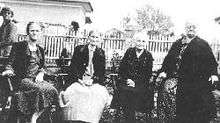
At the end of the American Civil War, the Emperor Dom Pedro II of Brazil was interested in having cotton crops due to the high prices and, through Freemasonry contacts, recruited experienced cotton farmers for his nation. Dom Pedro offered the potential immigrants subsidies and tax breaks. General Robert E. Lee advised Southerners not to flee to South America but many ignored his advice and set out to establish a new life away from the destruction of war.
Many Southerners who took the Emperor's offer had lost their land during the war, were unwilling to live under a conquering army, or simply did not expect an improvement in the South's economic position. In addition, Brazil would not outlaw slavery until 1888. Although a number of historians say that the existence of slavery was an appeal, Alcides Gussi, an independent researcher of State University of Campinas, found that only four families owned a total of 66 slaves from 1868 to 1875.
The American immigration to Brazil was started within that year of 1865, in small ships and sailboats hurriedly reshaped, "motivated more by the pain and feelings of despair than by the vessels themselves." They were exhausted men, women and children, many were very injured, others were sick and depressed, but they were determined to give a new start to their lives in faraway Brazil.
Between 1865 and 1885, almost ten thousand white Americans coming mainly from Alabama, Texas, Louisiana, South Carolina, Mississippi, Ohio, Virginia, Florida, Georgia, North Carolina, Arkansas, Kentucky and Tennessee ran ashore in the ports of Belém, Vitória, Rio de Janeiro and Santos. Once they arrived, they had to redouble their so weakened energies and confront other faraway and tough trips around the land until they could reach the region of Campinas, whose climate and lands are similar to those of the Southern United States.
It is unknown just how many immigrants went to Brazil as refugees from the war, but unpublished research in the records of the port of Rio de Janeiro by Betty Antunes de Oliveira counts some 20,000 Americans that entered Brazil from 1865 to 1885. Of those, an unknown number returned to the United States as conditions improved there. Many immigrants renounced their U.S. citizenship and adopted Brazilian citizenship.
The immigrants settled in various places in Brazil ranging from the urban areas of Rio de Janeiro and São Paulo to the northern Amazon region (especially Santarém) and Paraná in the south. But most of the Confederados settled in the area around present-day Santa Bárbara d'Oeste and Americana – this, derived from the name Vila dos Americanos. This was the name given by natives in the region because of its American population.
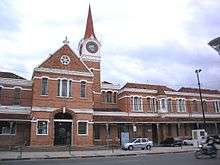
The first original Confederado known to arrive was the senator William H. Norris of Alabama—the colony at Santa Bárbara d'Oeste is sometimes called the Norris Colony. Dom Pedro's program was judged a success for both the immigrants and the Brazilian government.
American contributions to Brazilian Life
The American immigrants introduced into their new home many new foods, such as pecans, Georgia peanuts and watermelon; new tools such as the iron plow and kerosene lamps; innovations such as modern dentistry, modern agriculture, and the first blood transfusion; and the first non-Catholic churches (Baptist, Presbyterian, and Methodist). [5] Some foods of the American South also crossed over and became part of general Brazilian culture such as chess pie, vinegar pie, and southern fried chicken. The immigrants also established public schools and provided education to their female children, which was unusual in Brazil at the time.
Immigration in numbers
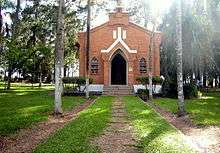
- American immigration to Brazil by State up to January (1867)[6]
| State | Immigrants |
|---|---|
| São Paulo | 800 |
| Espírito Santo | 400 |
| Rio de Janeiro | 200 |
| Paraná | 200 |
| Pará | 200 |
| Minas Gerais | 100 |
| Bahia | 85 |
| Pernambuco | 85 |
| Total | 2,070 |
The Confederate emigres were some 20,000 Southerners, from 12 southern states (i.e. Arkansas, Alabama and Mississippi) who preferred the Brazilian wilderness to life under Yankee rule after the Civil War.[7]
Descendants of the immigrants
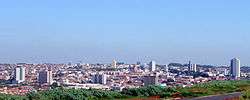
The first generation of Confederados remained an insular community, but by the third generation, most of the families had intermarried with native Brazilians or immigrants of other origins. Descendants of the Confederados increasingly spoke the Portuguese language and identified themselves as Brazilians. As the area around Santa Bárbara d'Oeste and Americana turned increasingly to the production of sugar cane and society became more mobile, the Confederados drifted to cities. Today, only a few descendant families still live on the original land owned by their ancestors. The descendants of the original Confederados are mostly scattered throughout Brazil but maintain the headquarters of their descendant organization at the Campo Cemetery, in Santa Bárbara D'Oeste.
The descendants maintain affection for the Confederate flag even though they all consider themselves completely Brazilian. Modern Confederados distance themselves from any of the racial controversies.
In Brazil, the Confederate flag has not previously had the racial stigma that has been attached to it in the United States.[8] Many descendants are of mixed-race and reflect the varied racial categories that make up Brazilian society in their physical appearance. Recently the Brazilian residents of Americana, now of primarily Italian descent, have removed the Confederate flag from the city's crest citing the fact that Confederados now make up only 10% of the city's population. The Confederate flag was associated with the city in the wake of Jimmy Carter's visit to the region.
In 1972, then Governor (and future President) Jimmy Carter of Georgia visited the city of Santa Bárbara d'Oeste and visited the grave of his wife Rosalyn's great-uncle who was one of the original Confederados.
Many Confederados have traveled to the United States at the invitation of the Sons of Confederate Veterans, an American descendants' organization, to visit Civil War battlefields, attend reenactments or see where their ancestors lived in the United States.
Confederado phrases in Brazil
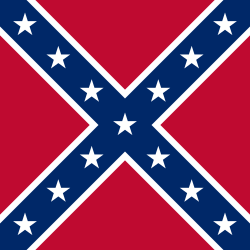
"...My father took part in the 1st Battalion that left Gonzalez. He was hurt in a battle in Virginia and sent back home, but he soon afterwards recovered and went back to the war. He was confined to prison and released. He returned home and once again returned to the battle field. "...In those days of shocking terror, both rebuilding and staying there turned impossible. Daily crimes surrounded us and there was nothing we could do..."[9]
"Our farm was beautiful, had several acres, good houses, horses and cattle. We had a corn mill, cotton-benefiting machineries (...) The Brazilian government received us very well, hosted us on the Immigrant Hotel, thus giving us shelter and food. It was my duty to explain that we were not immigrants. We were refugees. War refugees."[9]
"I have sugar cane, cotton, pumpkins, squash, five kinds of sweet potatoes, Irish potatoes, cornfield peas, snap beans, butter beans, ochre, tomatoes and fine chance at tobacco. I have a great variety of fruits on my place. I have made enough to live well on and am better pleased than other."[10]
"I remember when I was 4 years old, I was lost in a textile factory and I couldn't tell the people anything because I only spoke English", recalled an engineer and third-generation descendant. "I didn't learn Portuguese until I started school."[11]
"They came here because they felt that their 'country' had been invaded and their land confiscated," said great-granddaughter of the original McKnight family that moved to Brazil from Texas, in the Southern United States. "To them, there was nothing left there. So, they came here to try to re-create what they had before the war."[11] "I grew up listening to the stories. They were angry and bitter. When they talked about it, moving here, the war, leaving their homes, it was always a very sore subject for them."[11]
Culture
The center of Confederado culture is the Campo Cemetery in Santa Bárbara d'Oeste, where most of the original Confederados from the region were buried. Because of their Protestant religion, they established their own cemetery. The Confederado community has also established a Museum of Immigration at Santa Bárbara d'Oeste to present the history of Brazilian immigration and highlight its benefits to the nation.
The descendants still foster a connection with their history through the Fraternity of American Descendants, a descendant organization dedicated to preserving the unique mixed culture. The Confederados also have an annual festival, called the Festa Confederada which is dedicated to fund the Campo Cemetery. The festival is marked by Confederate flags, traditional dress of Confederate uniforms and hoop skirts, food of the American south with a Brazilian flair, and dances and music popular in the American south during the antebellum period.
Recent immigration
To increase profits, some farmers change what they grow. But some farmers in the American Midwest are changing where they grow. The Midwest is the traditional center of American agriculture. In Brazil, undeveloped land can cost two hundred forty dollars a hectare, or less. That is a little more than one-tenth the cost of land in the Midwest.[12] Some of the farmers see low-cost land in Brazil as a way to expand their operations. And it may serve other purposes. It may help keep farming in the family, by letting other family members have their own farm. Crops like soybeans and cotton grow well in Brazil's climate. The South American country has grown into a major agricultural exporter. It is the second largest exporter of soybeans after the United States. In the last five years, millions of hectares have been newly planted in Brazil.[13] Growth has been especially high in Central States with grassland known as "cerrado". It usually gets rain in summer and is dry in winter.
Education
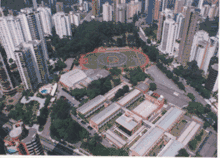
Today, Brazil is home to many American schools.[14]
- São Paulo: Escola Graduada, Chapel International School, Pan American Christian Academy, St. Francis College, American School of Campinas;
- Rio de Janeiro: American School of Rio de Janeiro, ICS – International Christian School – Rio, Our Lady of Mercy School;
- Federal District: American School of Brasília, Brasília International School;
- Minas Gerais: American School of Belo Horizonte;
- Rio Grande do Sul: Pan American School of Porto Alegre;
- Paraná: International School of Curitiba;
- Bahia: Pan American School of Bahia;
- Pernambuco: American School of Recife;
- Pará: Amazon Valley Academy;
- Amazonas: International School of Amazonas.
Notable people
- Bob Falkenburg
- Charles Frederick Hartt
- David Neeleman
- Dorothy Stang
- Eduardo Dougherty
- Ellen Gracie Northfleet
- Dionne Warwick
- Elsie Lessa
- Fabiana Semprebom
- Ivan Lessa
- José Lewgoy
- Júlio Ribeiro
- Orville Adalbert Derby
- Rita Lee
- Warwick Kerr
- Zuzu Angel
- Kátia Lund
- Lewis Joel Greene
- Llewellyn Ivor Price
- William Hutchinson Norris
- Larry Taylor
- Guy Ecker
- Arminio Fraga Neto
- Luís Inácio Adams
See also
References
- US Embassy in Brazil US Embassy in Brazil. Retrieved March 29, 2020.
- Confederate Colonies of Brazil Archived May 21, 2008, at the Wayback Machine
- [http://repositorio.unicamp.br/jspui/bitstream/REPOSIP/285998/1/Aguiar_Leticia_M.pdf%7CU.S. immigrants in Brazil|date=July 29, 2020}}
- "Visits to the U.S. by Foreign Heads of State and Government—1874–1939". 2001-2009.state.gov. Retrieved April 13, 2015.
- Orrizio, Riccardo. Lost White Tribes: The End of Privilege and the Last Colonials in Sri Lanka, Jamaica, Brazil, Haiti, Namibia, and Guadeloupe. Simon and Schuster, 2001, pages 110-111.
- Brasil: migrações internacionais e identidade
- Total U.S. Immigration
- Campbell, Bradley (June 23, 2015). "The town in Brazil that embraces the Confederate flag". United Kingdom: BBC. PRI. Retrieved June 23, 2015.
- Confederado phrases in Brazil
- Confederado phrases in Brazil
- Confederates histories in Brazil
- American Farmers Try Their Luck in Brazil
- Americans in Brazilian Agriculture
- American Schools in Brazil
Further reading
- Harter, Eugene C. (2000). The Lost Colony of the Confederacy. Texas A & M University Press. ISBN 1585441023.
